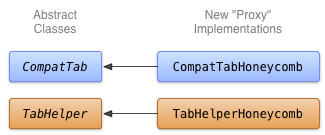本課程將說明如何將 CompatTab 和 TabHelper 抽象類別設為子類別,以及如何使用新的 API。在支援支援的平台版本的裝置上,您的應用程式可以使用這項實作。
使用新的 API 實作分頁
使用新版 API 的 CompatTab 和 TabHelper 具體類別是 Proxy 實作。由於上一課中定義的抽象類別會反映新的 API (類別結構、方法簽章等),因此使用這些新版 API 的具體類別只會代理方法呼叫及其結果。
由於延遲類別載入的關係,您可以在這些具體類別中直接使用新版 API,而不是在舊版裝置上當機。系統會在首次存取時載入及初始化類別,藉此例項化該類別,或首次存取其靜態欄位或方法。因此,只要您不在 Honeycomb 之前的裝置上將 Honeycomb 的特定實作項目例項化,Dalvik VM 就不會擲回任何 VerifyError 例外狀況。
為這個實作項目命名慣例,是附加具體類別所需 API 對應的 API 級別或平台版本代碼名稱。舉例來說,由於 CompatTabHoneycomb 和 TabHelperHoneycomb 類別需要使用 Android 3.0 (API 級別 11) 以上版本中可用的 API,因此可以提供原生分頁實作。

圖 1. 分頁 Honeycomb 實作方式的類別圖表。
實作 CompatTabHoneycomb
CompatTabHoneycomb 是 CompatTab 抽象類別的實作項目,TabHelperHoneycomb 用來參照個別分頁。CompatTabHoneycomb 只會 Proxy 對內含 ActionBar.Tab 物件的所有方法呼叫。
開始使用新的 ActionBar.Tab API 實作 CompatTabHoneycomb:
Kotlin
class CompatTabHoneycomb internal constructor(val activity: Activity, tag: String) : CompatTab(tag) { ... // The native tab object that this CompatTab acts as a proxy for. private var mTab: ActionBar.Tab = // Proxy to new ActionBar.newTab API activity.actionBar.newTab() override fun setText(@StringRes textId: Int): CompatTab { // Proxy to new ActionBar.Tab.setText API mTab.setText(textId) return this } ... // Do the same for other properties (icon, callback, etc.) }
Java
public class CompatTabHoneycomb extends CompatTab { // The native tab object that this CompatTab acts as a proxy for. ActionBar.Tab mTab; ... protected CompatTabHoneycomb(FragmentActivity activity, String tag) { ... // Proxy to new ActionBar.newTab API mTab = activity.getActionBar().newTab(); } public CompatTab setText(int resId) { // Proxy to new ActionBar.Tab.setText API mTab.setText(resId); return this; } ... // Do the same for other properties (icon, callback, etc.) }
實作 TabHelperHoneycomb
TabHelperHoneycomb 是 TabHelper 抽象類別的實作項目,它會透過 Proxy 方法呼叫實際的 ActionBar (從其包含的 Activity 中取得)。
實作 TabHelperHoneycomb,以 Proxy 處理對 ActionBar API 的方法呼叫:
Kotlin
class TabHelperHoneycomb internal constructor(activity: FragmentActivity) : TabHelper(activity) { private var mActionBar: ActionBar? = null override fun setUp() { mActionBar = mActionBar ?: mActivity.actionBar.apply { navigationMode = ActionBar.NAVIGATION_MODE_TABS } } override fun addTab(tab: CompatTab) { // Tab is a CompatTabHoneycomb instance, so its // native tab object is an ActionBar.Tab. mActionBar?.addTab(tab.getTab() as ActionBar.Tab) } }
Java
public class TabHelperHoneycomb extends TabHelper { ActionBar actionBar; ... protected void setUp() { if (actionBar == null) { actionBar = activity.getActionBar(); actionBar.setNavigationMode( ActionBar.NAVIGATION_MODE_TABS); } } public void addTab(CompatTab tab) { ... // Tab is a CompatTabHoneycomb instance, so its // native tab object is an ActionBar.Tab. actionBar.addTab((ActionBar.Tab) tab.getTab()); } // The other important method, newTab() is part of // the base implementation. }

